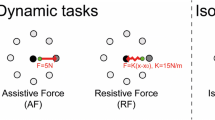Summary
A new method is presented which makes it possible to estimate from a series of experimental observations of isometric maximum-effort muscle torque, a set of myodynamic parameter values for each of a number of muscles contributing collectively to the total torque output. The parameters that can be estimated are: the individual maximum isometric forces; the spreads of the length-tension curves; the relative maximum isometric tendon extensions; and the optimum muscle lengths; most of which parameters could not be estimated previously. The method is described for both penniform and fusiform muscles, and is demonstrated using the human triceps muscle as an example. The values obtained by this method are in general agreement with comparable values obtained by in vitro methods.
Similar content being viewed by others
References
Bahler AS (1967) Series elastic component of mammalian skeletal muscle. Am J Physiol 213: 1560–1564
Cnockaert JC, Lensel G, Pertuzon E (1975) Relative contribution of individual muscles to the isometric contraction of a muscular group. J Biomech 8: 191–197
de Luca CJ, Forrest WJ (1973) Force analysis of individual muscles acting simultaneously on the shoulder joint during isometric abduction. J Biomech 6: 385–393
Edman KAP (1979) The velocity of unloaded shortening and its relation to sarcomere length and isometric force in vertebrate muscle fibres. J Physiol 291: 143–159
Franke F (1920) Die Kraftkurve menschlicher Muskeln bei willokürlicher Innervation und die Frage der absoluten Muskelkraft. Pflügers Arch Gesamte Physiol 184: 300–322
Gordon AM, Huxley AF, Julian FJ (1966) The variation in isometric tension with sarcomere length in vertebrate muscle fibres. J Physiol 184: 170–192
Hatze H (1977) A myocybernetic control model of skeletal muscle. Biol Cybern 25: 103–119
Hatze H (1978) A general myocybernetic control model of skeletal muscle. Biol Cybern 28: 143–157
Hatze H (1980a) A mathematical model for the computational determination of parameter values of anthropomorphic segments. J Biomech 13: 833–843
Hatze H (1980b) Neuro-musculoskeletal control systems modelling — a critical survey of recent developments. IEEE Trans Autom Control 25: 375–385
Hatze H (1980c) Myocybernetic control models of skeletal muscle — characteristics and applications. University of South Africa Press, Pretoria
Hatze H (1980d) Optimal processes of neuro-musculoskeletal control systems. In: Getz WM (ed) Mathematical modelling in biology and ecology. Springer, Berlin Heidelberg New York, pp 23–39
Hatze H (1981) A comprehensive model for human motion simulation and its application to the take-off phase of the long jump. J Biomech 14: 135–142
Hill DK (1968) Tension due to interaction between the sliding filaments in resting striated muscle. The effect of stimulation. J Physiol 199: 637–684
Hof AL, van den Berg J (1977) Linearity between the weighted sum of the EMGs of the human triceps surae and the total torque. J Biomech 10: 529–539
Jackson KM, Joseph J, Wyard SJ (1977) Sequential muscular contraction. J Biomech 10: 97–106
Komi PV, Viitasalo HT (1976) Signal characteristics of EMG at different levels of muscle tension. Acta Physiol Scand 96: 267–276
Maton B, Bouisset S (1977) The distribution of activity among the muscles of a single group during isometric contraction. Eur J Appl Physiol 37: 101–109
Ramsey RW, Street SF (1940) The isometric length-tension diagram of isolated skeletal muscle fibres of the frog. J Cell Comp Physiol 15: 11–34
Stevens JC, Dickinson V, Jones NB (1980) Mechanical properties of human skeletal muscle from in vitro studies of biopsies. Med Biol Eng Comput 18: 1–9
Wilkie DR (1956) The mechanical properties of muscle. Br Med Bull 12: 177–182
Author information
Authors and Affiliations
Rights and permissions
About this article
Cite this article
Hatze, H. Estimation of myodynamic parameter values from observations on isometrically contracting muscle groups. Europ. J. Appl. Physiol. 46, 325–338 (1981). https://doi.org/10.1007/BF00422120
Accepted:
Issue Date:
DOI: https://doi.org/10.1007/BF00422120




